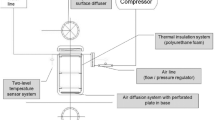Abstract
The optimization of process parameters for decomposition of kitchen waste into mature, stable compost was investigated using response surface methodology (RSM). RSM and central composite designs were applied to evaluate and optimize the key factors namely fly ash, bulking agent for moisture optimization and temperature, inoculum size and lime concentration for C/N optimization, which affect the stability of compost. Moisture and C/N ratio were selected as response variables. The experimental data of response variables were fitted into quadratic polynomial model using the multiple regression analysis and found it was statistically significant quadratic model. Box–Behnken design under RSM was used to optimize their interaction between bulking agent (40 %) and fly ash (15 %) has significant effect on moisture optimization and temperature (35 °C), lime (3 %), and inoculum size (10 %) were the best for C/N ratio optimization and compost maturity. These optimized conditions were used and recorded the 50 % moisture reduction, and 8.43 C/N was achieved; indicates the stable and mature compost in minimum time. A significant correlation was also found between C/N ratio, humic acid, fulvic acid and degree of polymerization during compost formation. It was fleetingly concluded that optimization of compost parameters promote the decomposition rate and humification process.


Similar content being viewed by others
References
Aparna C, Saritha P, Himabindu V, Anjaneyulu Y (2008) Techniques for the evaluation of maturity for composts of industrially contaminated lake sediments. Waste Manag 28:1773–1784
APHA (2005) Standard methods for the examination of water and waste water, 21st edn. APHA, Washington, pp 34–40
Bailey SJ, Baldini NC (2007) Annual book of ASTM standards. ASTM International, USA, 11.04, pp 775–776
Bazaraa WA, Hassan EE (1996) Response surface optimization for the continuous glucose isomerization process. J Ind Microbiol 17:100–103
Chang JI, Tsai JJ, Wu KH (2006) Thermophilic composting of food waste. Bioresour Technol 97(1):116–122
Fang M, Wong JWC (1999) Effects of lime amendment on availability of heavy metals and maturation in sewage sludge composting. Environ Pollut 106(1):83–89
Gao M, Liang F, Yu A, Yang L (2010) Evaluation of stability and maturity during forced aeration composting of chicken manure and sawdust at different C/N ratios. Chemosphere 78:614–619
Golueke CG (1981) Principles of biological resources recovery. Biocycle 22:36–40
Guo R, Li G, Jiang T, Schuchardt F, Chen T, Zhao Y, Shen Y (2012) Effect of aeration rate, C/N ratio and moisture content on the stability and maturity of compost. Bioresour Technol 112:171–178
Hay JXW, Wu TY, Teh CY, Jahim JM (2012) Optimized growth of Rhodobacter sphaeroides O.U.001 using response surface methodology (RSM). J Sci Ind Res 71:149–154
Iqbal MK, Shafiq T, Ahmed K (2010a) Effect of different techniques of composting on stability and maturity of municipal solid waste compost. Environ Technol 31:205–214
Iqbal MK, Shafiq T, Hussain A, Ahmed K (2010b) Effect of enrichment on chemical properties of MSW compost. Bioresour Technol 101(15):5969–5977
Jadhav SB, Surwase SN, Phugare SS, Jadhav JP (2013) Response surface methodology mediated optimization of Remazol Orange decolorization in plain distilled water by Pseudomonas aeruginosa BCH. Int J Environ Technol 10:181–190
Kulcu R, Yaldiz O (2004) Determination of aeration rate and kinetics of composting some agricultural wastes. Bioresour Technol 93(1):49–57
Kumar M, Ou YL, Lin JG (2010) Co-composting of green waste and food waste at low C/N ratio. Waste Manag 30(4):602–609
Mannan S, Fakhrul-Razi A, Alam MZ (2007) Optimization of process parameters for the bioconversion of activated sludge by Penicillium corylophilum using response surface methodology. J Environ Sci 19(1):23–28
Said-Pullicino D, Erriquens FG, Gigliotti G (2007) Changes in the chemical characteristics of water-extractable organic matter during composting and their influence on compost stability and maturity. Bioresour Technol 98(9):1822–1831
Senesi N (1989) Composted materials as organic fertilizers. Sci Total Environ 81:543–550
Sundberg C, Yu D, Whittle IF, Kauppi S, Smars S, Insam H, Romantschuk M, Jonsson H (2013) Effects of pH and microbial composition on odour in food waste composting. Waste Manag 33(1):204–211
Tejada M, Garcia-Martinez AM, Parrado J (2009) Relationships between biological and chemical parameters on the composting of a municipal solid waste. Bioresour Technol 100:4062–4065
Usharani K, Muthukumar M (2013) Optimization of aqueous methylparathion biodegradation by Fusarium sp in batch scale process using response surface methodology. Int J Environ Sci Technol 10:591–606
Wang YX, Lu ZX (2005) Optimization of processing parameters for the mycelia growth and extracellular polysaccharide production by Boletus spp. ACCC 50328. Process Biochem 40:1043–1051
Wong JWC, Fang M (2000) Effect of lime addition on sewage sludge composting process. Water Res 34(15):3691–3698
Wong JWC, Fung SO, Selvam A (2009) Coal fly ash and lime addition enhances the rate and efficiency of decomposition of food waste during composting. Bioresour Technol 100:3324–3331
Acknowledgments
The present research was conducted and supported by Pakistan Council of Scientific and Industrial Research (PCSIR) Lahore with collaboration of university of Lahore; Raiwind road, Lahore, Pakistan.
Author information
Authors and Affiliations
Corresponding author
Rights and permissions
About this article
Cite this article
Iqbal, M.K., Nadeem, A., Sherazi, F. et al. Optimization of process parameters for kitchen waste composting by response surface methodology. Int. J. Environ. Sci. Technol. 12, 1759–1768 (2015). https://doi.org/10.1007/s13762-014-0543-x
Received:
Revised:
Accepted:
Published:
Issue Date:
DOI: https://doi.org/10.1007/s13762-014-0543-x




